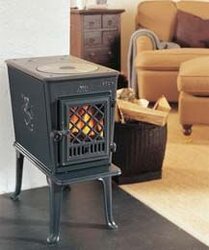We have a cement column, sort of in the middle of a room. It has a 6 inch clay lined flue located 25 inches off the floor. This is making it difficult to find a stove low enough to vent properly. We found the Jotul 602 to be just the right height. In order to make it vent well, I’m wondering if it would be okay to connect the pipe off the back of the stove directly to the flue liner in the column, rather than getting more pipe to connect the two ends. It would also help with function of the room to have the stove back further. Is it okay to have the stove nearly touching the cement column? The Jotul website makes it look so nice this way… but maybe its just for the catalog?
Also, is it easy enough to spread a layer of cement around to coat my column of cement blocks - so that I can paint it and achieve the look in the picture? Would I need to wrap the column in some kind of wire first? And would I need to use a special kind of heat resistant paint?
Also, is it easy enough to spread a layer of cement around to coat my column of cement blocks - so that I can paint it and achieve the look in the picture? Would I need to wrap the column in some kind of wire first? And would I need to use a special kind of heat resistant paint?


